Modulation of Electronic Availability in g-C3N4 Using Nickel (II), Manganese (II), and Copper (II) to Enhance the Disinfection and Photocatalytic Properties
Abstract
:1. Introduction
2. Results
2.1. Morphology and Spectroscopic Characterization of g-C3N4 and Modified Materials with Copper (II), Manganese (II), and Nickel (II)
2.2. Electrochemical Characterization of g-C3N4 and Copper (II)-, Manganese (II)-, and Nickel (II)-Modified Materials
2.3. Photocatalytic Disinfection against E. coli 25922 Using g-C3N4 and Modified Materials with Copper (II), Manganese (II), and Nickel (II)
2.4. Understanding the Disinfection Mechanism of Cu-g-C3N4
3. Discussion
4. Materials and Methods
4.1. Reagents
4.2. Modification of g-C3N4 Synthesis
4.3. Physicochemical and Spectroscopic Characterization
4.4. Electrochemical Characterization
4.5. Reaction System
4.6. E. coli 25922 Photodisinfection
4.7. Dicloxacillin Degradation
4.8. Theoretical Approximations of g-C3N4 and Modified Materials with Copper (II)
5. Conclusions
Supplementary Materials
Author Contributions
Funding
Institutional Review Board Statement
Informed Consent Statement
Data Availability Statement
Acknowledgments
Conflicts of Interest
References
- Hong Hak, C.; Ching Sim, L.; Leong, K.H.; Chin, Y.H.; Saravanan, P. Sunlight Photodeposition of Gold nanoparticles onto Graphitic Carbon Nitride (g-C3N4) and Application Towards the Degradation of Bisphenol A. IOP Conf. Ser. Mater. Sci. Eng. 2018, 409, 012008. [Google Scholar] [CrossRef]
- Alizadeh, T.; Rafiei, F. An innovative application of graphitic carbon nitride (g-C3N4) nano-sheets as silver ion carrier in a solid state potentiometric sensor. Mater. Chem. Phys. 2019, 227, 176–183. [Google Scholar] [CrossRef]
- Afshari, M.; Dinari, M.; Momeni, M.M. Ultrasonic irradiation preparation of graphitic-C3N4/polyaniline nanocomposites as counter electrodes for dye-sensitized solar cells. Ultrason. Sonochem. 2018, 42, 631–639. [Google Scholar] [CrossRef] [PubMed]
- Li, K.; Su, F.Y.; Zhang, W. De Modification of g-C3N4 nanosheets by carbon quantum dots for highly efficient photocatalytic generation of hydrogen. Appl. Surf. Sci. 2016, 375, 110–117. [Google Scholar] [CrossRef]
- Ye, C.; Li, J.X.; Li, Z.J.; Li, X.B.; Fan, X.B.; Zhang, L.P.; Chen, B.; Tung, C.H.; Wu, L.Z. Enhanced Driving Force and Charge Separation Efficiency of Protonated g-C3N4 for Photocatalytic O2 Evolution. ACS Catal. 2015, 5, 6973–6979. [Google Scholar] [CrossRef]
- Huang, D.; Yan, X.; Yan, M.; Zeng, G.; Zhou, C.; Wan, J.; Cheng, M.; Xue, W. Graphitic Carbon Nitride-Based Heterojunction Photoactive Nanocomposites: Applications and Mechanism Insight. ACS Appl. Mater. Interfaces 2018, 10, 21035–21055. [Google Scholar] [CrossRef]
- Wang, K.; Li, J.; Zhang, G. Ag-Bridged Z-Scheme 2D/2D Bi5FeTi3O15/g-C3N4 Heterojunction for Enhanced Photocatalysis: Mediator-Induced Interfacial Charge Transfer and Mechanism Insights. ACS Appl. Mater. Interfaces 2019, 11, 27686–27696. [Google Scholar] [CrossRef] [PubMed]
- Dong, F.; Zhao, Z.; Xiong, T.; Ni, Z.; Zhang, W.; Sun, Y.; Ho, W.K. In situ construction of g-C3N4/g-C3N4 metal-free heterojunction for enhanced visible-light photocatalysis. ACS Appl. Mater. Interfaces 2013, 5, 11392–11401. [Google Scholar] [CrossRef]
- Liu, G.; Dong, G.; Zeng, Y.; Wang, C. The photocatalytic performance and active sites of g-C3N4 effected by the coordination doping of Fe(III). Chin. J. Catal. 2020, 41, 1564–1572. [Google Scholar] [CrossRef]
- Shan, Q.Y.; Guo, X.L.; Dong, F.; Zhang, Y.X. Single atom (K/Na) doped graphitic carbon Nitride@MnO2 as an efficient electrode Material for supercapacitor. Mater. Lett. 2017, 202, 103–106. [Google Scholar] [CrossRef]
- Savateev, A.; Ghosh, I.; König, B.; Antonietti, M. Photoredox Catalytic Organic Transformations using Heteroge-neous Carbon Nitrides. Angew. Chem. Int. Ed. Engl. 2018, 57, 15936–15947. [Google Scholar] [CrossRef] [PubMed]
- Ghosh, I.; Khamrai, J.; Savateev, A.; Shlapakov, N.; Antonietti, M.; König, B. Organic semiconductor photocatalyst can bifunctionalize arenes and heteroarenes. Science 2019, 365, 360–366. [Google Scholar] [CrossRef] [PubMed]
- Wang, J.; Wang, S. A critical review on graphitic carbon nitride (g-C3N4)-based materials: Preparation, modification and environmental application. Coord. Chem. Rev. 2022, 453, 214338. [Google Scholar] [CrossRef]
- Zheng, Y.; Jiao, Y.; Zhu, Y.; Cai, Q.; Vasileff, A.; Li, L.H.; Han, Y.; Chen, Y.; Qiao, S.Z. Molecule-Level g-C3N4 Coordinated Transition Metals as a New Class of Electrocatalysts for Oxygen Electrode Reactions. J. Am. Chem. Soc. 2017, 139, 3336–3339. [Google Scholar] [CrossRef] [PubMed]
- Zhou, W.C.; Zhang, W. De Anchoring nickel complex to g-C3N4 enables an efficient photocatalytic hydrogen evolution reaction through ligand-to-metal charge transfer mechanism. J. Colloid Interface Sci. 2022, 616, 791–802. [Google Scholar] [CrossRef] [PubMed]
- Capobianco, M.D.; Pattengale, B.; Neu, J.; Schmuttenmaer, C.A. Single Copper Atoms Enhance Photoconductivity in g-C3N4. J. Phys. Chem. Lett. 2020, 11, 8873–8879. [Google Scholar] [CrossRef] [PubMed]
- Li, W.; Liu, M.; Cheng, S.; Zhang, H.; Yang, W.; Yi, Z.; Zeng, Q.; Tang, B.; Ahmad, S.; Sun, T. Polarization-independent tunable bandwidth absorber based on single-layer graphene. Diam. Relat. Mater. 2024, 142, 110793. [Google Scholar] [CrossRef]
- Li, X.; Yu, J.; Wageh, S.; Al-Ghamdi, A.A.; Xie, J. Graphene in Photocatalysis: A Review. Small. 2016, 12, 6640–6696. [Google Scholar] [CrossRef] [PubMed]
- Jiang, B.Q.; Hou, Y.G.; Wu, J.X.; Ma, Y.X.; Gan, X.T. In-fiber photoelectric device based on graphene-coated tilted fiber grating. Opto-Electron. Sci. 2023, 2, 230012. [Google Scholar] [CrossRef]
- Zeng, C.; Lu, H.; Mao, D.; Du, Y.Q.; Hua, H. Graphene-empowered dynamic metasurfaces and metadevices. Opto-Electron. Adv. 2022, 5, 200098. [Google Scholar] [CrossRef]
- Zhou, F.Y.; Mao, J.N.; Peng, X.L.; Hong, B.; Xu, J.C.; Zeng, Y.X.; Han, Y.B.; Ge, H.L.; Wang, X.Q. Magnetically separable Ni/g-C3N4 nanocomposites for enhanced visible-light photocatalytic degradation of methylene blue and ciprofloxacin. Diam. Relat. Mater. 2022, 126, 109070. [Google Scholar] [CrossRef]
- Zhang, Z.; Qiu, C.; Xu, Y.; Han, Q.; Tang, J.; Loh, K.P.; Su, C. Semiconductor photocatalysis to engineering deuterated N-alkyl pharmaceuticals enabled by synergistic activation of water and alkanols. Nat. Commun. 2020, 11, 4722. [Google Scholar] [CrossRef] [PubMed]
- Parasuraman, V.; Perumalswamy Sekar, P.; Mst Akter, S.; Ram Lee, W.; Young Park, T.; Gon Kim, C.; Kim, S. Improved photocatalytic disinfection of dual oxidation state (dos)-Ni/g-C3N4 under indoor daylight. J. Photochem. Photobiol. A Chem. 2023, 434, 114262. [Google Scholar] [CrossRef]
- Kundu, A.; Pousty, D.; Kumar Vadivel, V.; Mamane, H. Cu-coated graphitic carbon nitride (Cu/CN) with ideal photocatalytic and antibacterial properties. Carbon Trends 2023, 13, 100307. [Google Scholar] [CrossRef]
- Zhang, H.; Ren, X.; Zhang, B.; Jia, A.; Wang, Y. Size Effect of Cu Nanoparticles in Cu/g-C3N4 Composites on Properties for Highly Efficient Photocatalytic Reduction of CO2 to Methanol. ACS Appl. Mater. Interfaces 2023, 15, 53515–53525. [Google Scholar] [CrossRef]
- Qian, W.; Fang, Y.; Liu, H.; Deng, Y.; Li, Y.; Zhang, Y.; Diao, Z.; Li, M. Photocatalytic Degradation of Tetracycline Hydrochloride by Mn/g-C3N4/BiPO4 and Ti/g-C3N4/BiPO4 Composites: Reactivity and Mechanism. Catalysts 2023, 13, 1398. [Google Scholar] [CrossRef]
- Lin, C.; Su, J.; Chen, Z. Photocatalytic oxidative degradation of methyl orange by a novel g-C3N4@ZnO based on graphene oxide composites with ternary heterojunction construction. React. Kinet. Mech. Catal. 2022, 135, 1651–1664. [Google Scholar] [CrossRef]
- Xu, X.; Wang, S.; Hu, T.; Yu, X.; Wang, J.; Jia, C. Fabrication of Mn/O co-doped g-C3N4: Excellent charge separation and transfer for enhancing photocatalytic activity under visible light irradiation. Dye Pigment. 2020, 175, 108107. [Google Scholar] [CrossRef]
- Murugesan, P.; Moses, J.A.; Anandharamakrishnan, C. Photocatalytic disinfection efficiency of 2D structure graphitic carbon nitride-based nanocomposites: A review. J. Mater. Sci. 2019, 54, 12206–12235. [Google Scholar] [CrossRef]
- Yang, X.; Ye, Y.; Sun, J.; Li, Z.; Ping, J.; Sun, X. Recent Advances in g-C3N4-Based Photocatalysts for Pollutant Degradation and Bacterial Disinfection: Design Strategies, Mechanisms, and Applications. Small 2022, 18, 2105089. [Google Scholar] [CrossRef]
- Liu, X.; Ma, R.; Zhuang, L.; Hu, B.; Chen, J.; Liu, X.; Wang, X. Recent developments of doped g-C3N4 photocatalysts for the degradation of organic pollutants. Crit. Rev. Environ. Sci. Technol. 2021, 51, 751–790. [Google Scholar] [CrossRef]
- Cao, C.-B.; Lv, Q.; Zhu, H.-S. Carbon nitride prepared by solvothermal method. Diam. Relat. Mater. 2003, 12, 1070–1074. [Google Scholar] [CrossRef]
- Ge, L.; Han, C.; Liu, J.; Li, Y. Enhanced visible light photocatalytic activity of novel polymeric g-C3N4 loaded with Ag nanoparticles. Appl. Catal. A Gen. 2011, 409–410, 215–222. [Google Scholar] [CrossRef]
- Yang, Y.; Bian, Z. Oxygen doping through oxidation causes the main active substance in g-C3N4 photocatalysis to change from holes to singlet oxygen. Sci. Total Environ. 2021, 753, 141908. [Google Scholar] [CrossRef] [PubMed]
- Muñoz-Batista, M.J.; Andrini, L.; Requejo, F.G.; Gómez-Cerezo, M.N.; Fernández-García, M.; Kubacka, A. Sunlight active g-C3N4-based Mn+ (M[dbnd]Cu, Ni, Zn, Mn)—Promoted catalysts: Sharing of nitrogen atoms as a door for optimizing photo-activity. Mol. Catal. 2020, 484, 110725. [Google Scholar] [CrossRef]
- Sellers, S.P.; Korte, B.J.; Fitzgerald, J.P.; Reiff, W.M.; Yee, G.T. Canted ferromagnetism and other magnetic phenomena in square- planar, neutral manganese(II) and iron(II) octaethyltetraazaporphyrins. J. Am. Chem. Soc. 1998, 120, 4662–4670. [Google Scholar] [CrossRef]
- Shimizu, I.; Morimoto, Y.; Faltermeier, D.; Kerscher, M.; Paria, S.; Abe, T.; Sugimoto, H.; Fujieda, N.; Asano, K.; Suzuki, T.; et al. Tetrahedral Copper(II) Complexes with a Labile Coordination Site Supported by a Tris-tetramethylguanidinato Ligand. Inorg. Chem. 2017, 56, 9634–9645. [Google Scholar] [CrossRef]
- Fina, F.; Callear, S.K.; Carins, G.M.; Irvine, J.T.S. Structural investigation of graphitic carbon nitride via XRD and neutron diffraction. Chem. Mater. 2015, 27, 2612–2618. [Google Scholar] [CrossRef]
- Li, F.; Zhang, L.; Evans, D.G.; Duan, X. Structure and surface chemistry of manganese-doped copper-based mixed metal oxides derived from layered double hydroxides. Colloids Surfaces A Physicochem. Eng. Asp. 2004, 244, 169–177. [Google Scholar] [CrossRef]
- Zhao, J.; Chen, C.; Ma, W. Photocatalytic Degradation of Organic Pollutants Under Visible Light Irradiation. Top Catal. 2005, 35, 269–278. [Google Scholar] [CrossRef]
- Spanish-Number 49g. 2023. Available online: www.HealthLinkBC.ca/more/resources/healthlink-bc-files (accessed on 19 May 2024).
- Zhu, D.; Zhou, Q. Novel Bi2WO6 modified by N-doped graphitic carbon nitride photocatalyst for efficient photocatalytic degradation of phenol under visible light. Appl. Catal. B Environ. 2020, 268, 118426. [Google Scholar] [CrossRef]
- Acosta-Vergara, J.; Torres-Palma, R.A.; Ávila-Torres, Y. Solid state pelletizing for the synthesis of new Bi-doped strontium molybdate and its development as a photocatalytic precursor for Rhodamine B degradation. MethodsX 2023, 11, 102258. [Google Scholar] [CrossRef]
- Biesinger, M.C.; Payne, B.P.; Lau, L.W.M.; Gerson, A.; Smart, R.S.C. X-ray photoelectron spectroscopic chemical state Quantification of mixed nickel metal, oxide and hydroxide systems. Surf. Interface Anal. 2009, 41, 324–332. [Google Scholar] [CrossRef]
- Pourbaix, M.; Zhang, H.; Pourbaix, A. Presentation of an Atlas of chemical and electrochemical equilibria in the presence of a gaseous phase. Mater. Sci. Forum 1997, 251–254, 143–148. [Google Scholar] [CrossRef]
- Torres, L.M.; Montes-Rojas, A. Conversión de potenciales entre distintos electrodos de referencia: Una analogía para facilitar su comprensión. Boletín Soc. Química México 2017, 11, 12–14. [Google Scholar]
- Johnstone, A.H. CRC Handbook of Chemistry and Physics—69th Edition Editor in Chief R. C. Weast, CRC Press Inc., Boca Raton, Florida, 1988, pp. 2400, price £57.50. ISBN 0-8493-0369-5. J. Chem. Technol. Biotechnol. 1991, 50, 294–295. [Google Scholar] [CrossRef]
- Ávila-Torres, Y.; López-Sandoval, H.; Mijangos, E.; Quintanar, L.; Rodríguez, E.E.; Flores-Parra, A.; Contreras, R.; Vicente, R.; Rikken, G.L.J.A.; Barba-Behrens, N. Structure and magnetic properties of copper(II) and cobalt(II) coordination compounds derived from optically active tridentate ligands. Polyhedron 2013, 51, 298–306. [Google Scholar] [CrossRef]
- Jiang, L.; Yuan, X.; Pan, Y.; Liang, J.; Zeng, G.; Wu, Z.; Wang, H. Doping of graphitic carbon nitride for photocatalysis: A reveiw. Appl. Catal. B Environ. 2017, 217, 388–406. [Google Scholar] [CrossRef]
- Dong, G.; Zhang, Y.; Pan, Q.; Qiu, J. A fantastic graphitic carbon nitride (gC3N4) material: Electronic structure, photocatalytic and photoelectronic properties. J. Photochem. Photobiol. C Photochem. Rev. 2014, 20, 33–50. [Google Scholar] [CrossRef]
- Yu, H.; Jiang, X.; Shao, Z.; Feng, J.; Yang, X.; Liu, Y. Metal-Free Half-Metallicity in B-Doped gh-C3N4 Systems. Nanoscale Res. Lett. 2018, 13, 1–7. [Google Scholar] [CrossRef]
- Zhu, C.; Fang, Q.; Liu, R.; Dong, W.; Song, S.; Shen, Y. Insights into the Crucial Role of Electron and Spin Structures in Heteroatom-Doped Covalent Triazine Frameworks for Removing Organic Micropollutants. Environ. Sci. Technol. 2022, 56, 6699–6709. [Google Scholar] [CrossRef] [PubMed]
- Cai, H.; Yang, Q.; Hu, Z.; Duan, Z.; You, Q.; Sun, J.; Xu, N.; Wu, J. Enhanced photoelectrochemical activity of vertically aligned ZnO-coated TiO2 nanotubes. Appl. Phys. Lett. 2014, 104, 053114. [Google Scholar] [CrossRef]
- Gelderman, K.; Lee, L.; Donne, S.W. Flat-band potential of a semiconductor: Using the Mott-Schottky equation. J. Chem. Educ. 2007, 84, 685–688. [Google Scholar] [CrossRef]
- Gao, J.; Xue, J.; Jia, S.; Shen, Q.; Zhang, X.; Jia, H.; Liu, X.; Li, Q.; Wu, Y. Self-Doping Surface Oxygen Vacancy-Induced Lattice Strains for Enhancing Visible Light-Driven Photocatalytic H2Evolution over Black TiO2. ACS Appl. Mater. Interfaces 2021, 13, 18758–18771. [Google Scholar] [CrossRef] [PubMed]
- Torres-Palma, R.A.; Serna-Galvis, E.A.; Ávila-Torres, Y.P. Chapter 12—Photochemical and photocatalytical degradation of antibiotics in water promoted by solar irradiation. In Nano-Materials as Photocatalysts for Degradation of Environmental Pollutants; Elsevier: Amsterdam, The Netherlands, 2020; pp. 211–243. [Google Scholar] [CrossRef]
- Shaban, S.Y.; Ramadan, A.E.M.M.; Ibrahim, M.M.; Elshami, F.I.; van Eldik, R. Square planar versus square pyramidal copper(II) complexes containing N3O moiety: Synthesis, structural characterization, kinetic and catalytic mimicking activity. Inorganica Chim. Acta 2019, 486, 608–616. [Google Scholar] [CrossRef]
- Romero-Hernandez, J.J.; Paredes-Laverde, M.; Silva-Agredo, J.; Mercado, D.F.; Ávila-Torres, Y.; Torres-Palma, R.A. Pharmaceutical adsorption on NaOH-treated rice husk-based activated carbons: Kinetics, thermodynamics, and mechanisms. J. Clean. Prod. 2024, 434, 139935. [Google Scholar] [CrossRef]
- Book of Standards Volume: 03.01; Developed by Subcommittee: E04.11; ICS Code: 71.040.50; ASTM International: West Conshohocken, PA, USA, 2019; 9p. [CrossRef]
- Suarez, M.; Caicedo, C.; Morales, J.; López, E.F.; Torres, Y. Design, theoretical study and correlation of the electronic and optical properties of diethynylphenylthiophene as photovoltaic materials. J. Mol. Struct. 2020, 1201, 127093. [Google Scholar] [CrossRef]
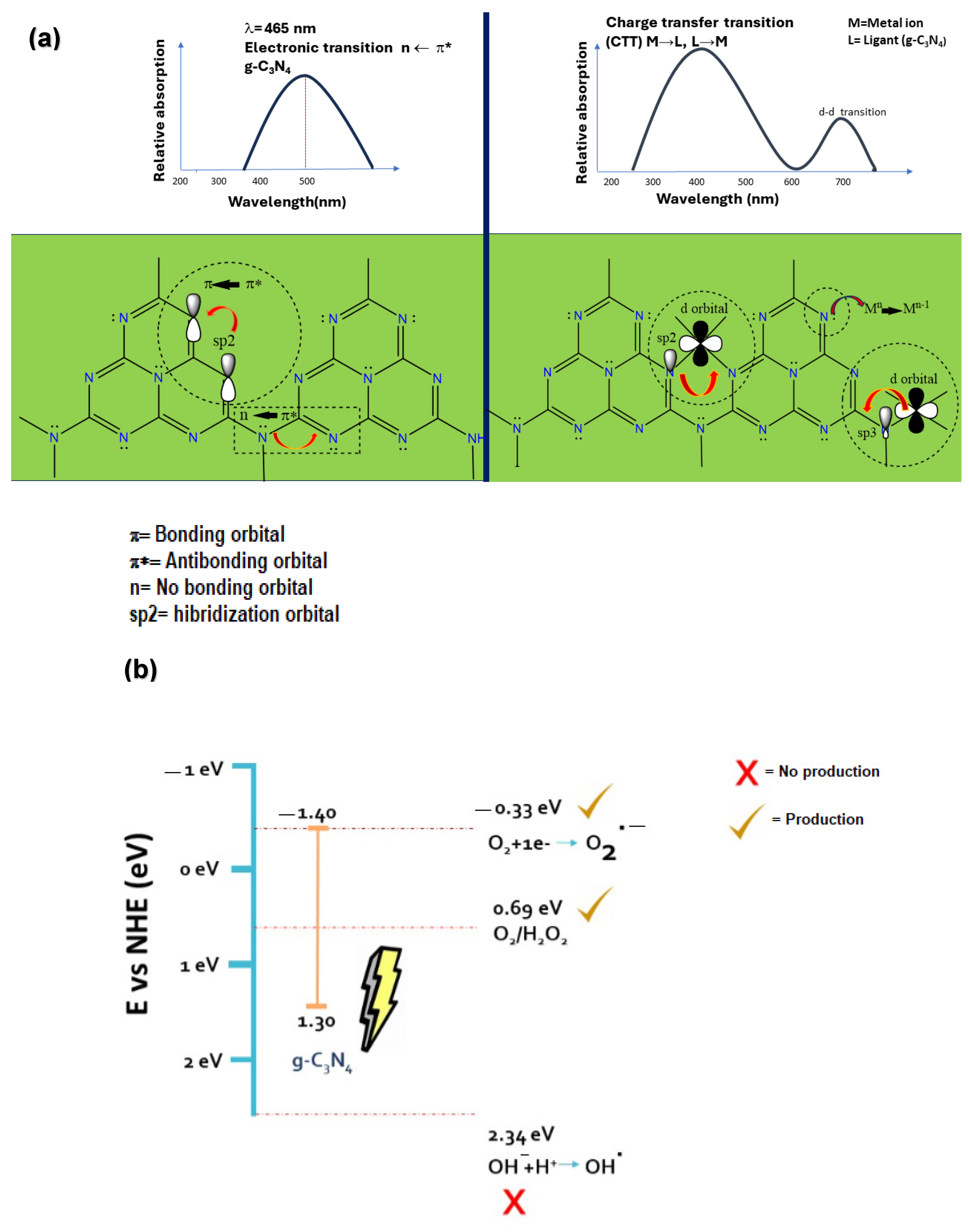
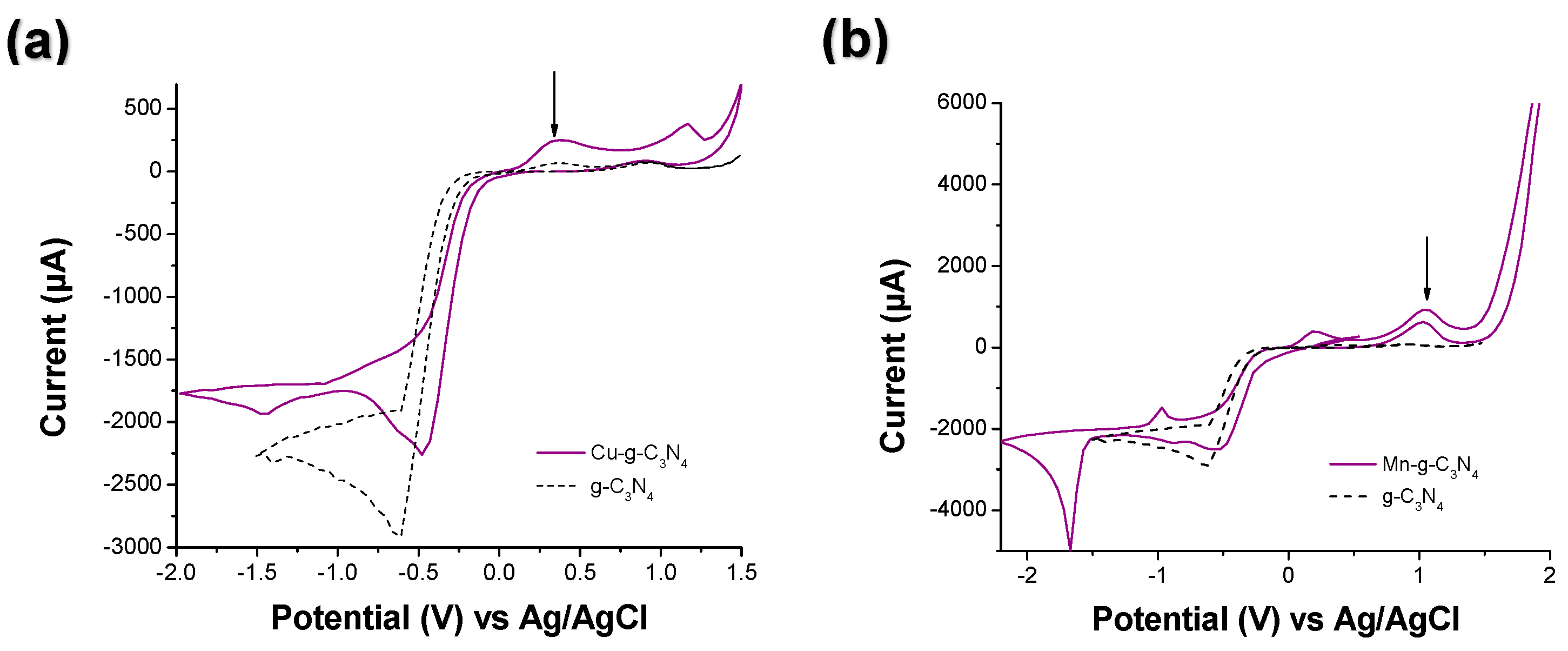
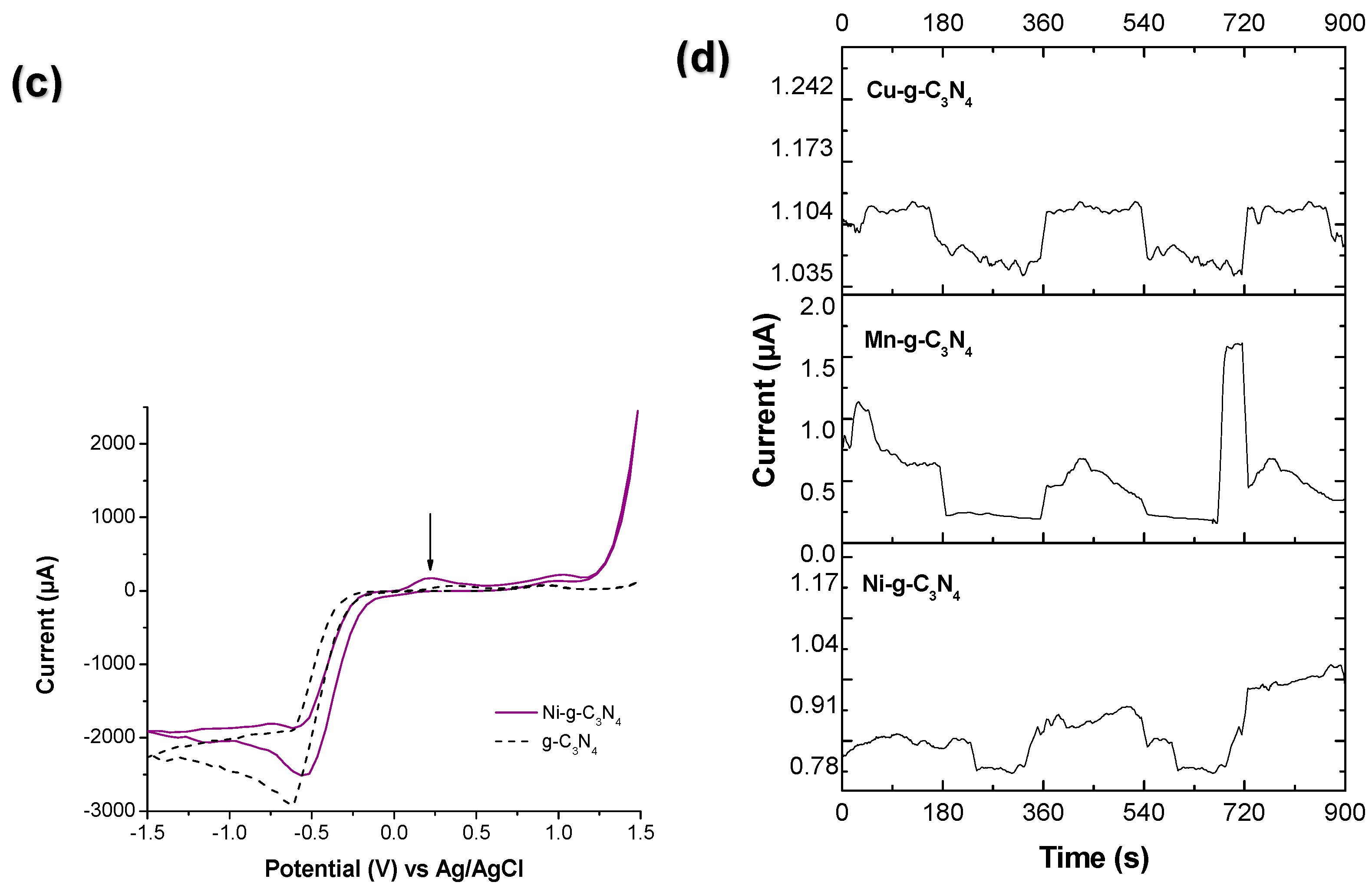
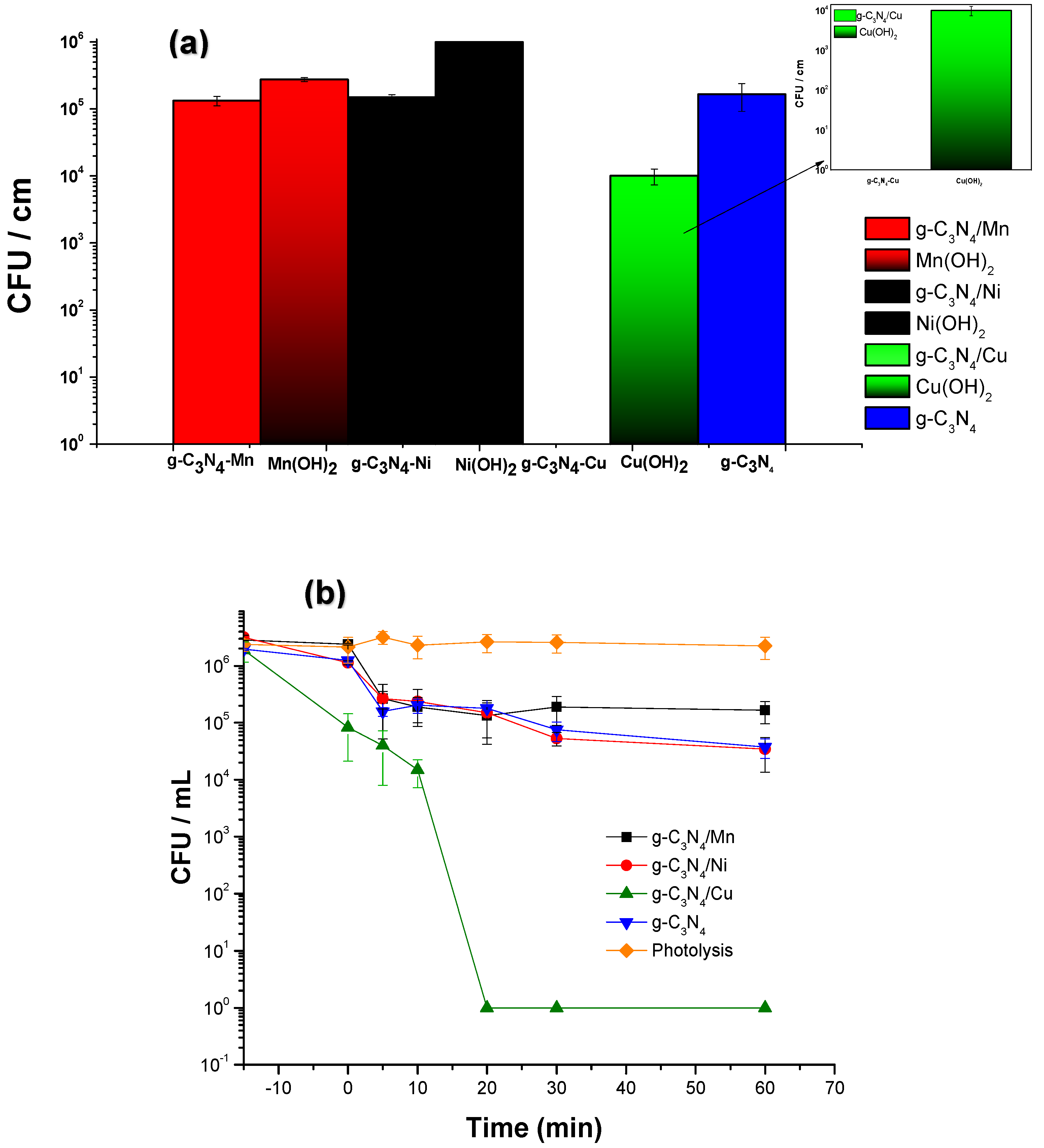
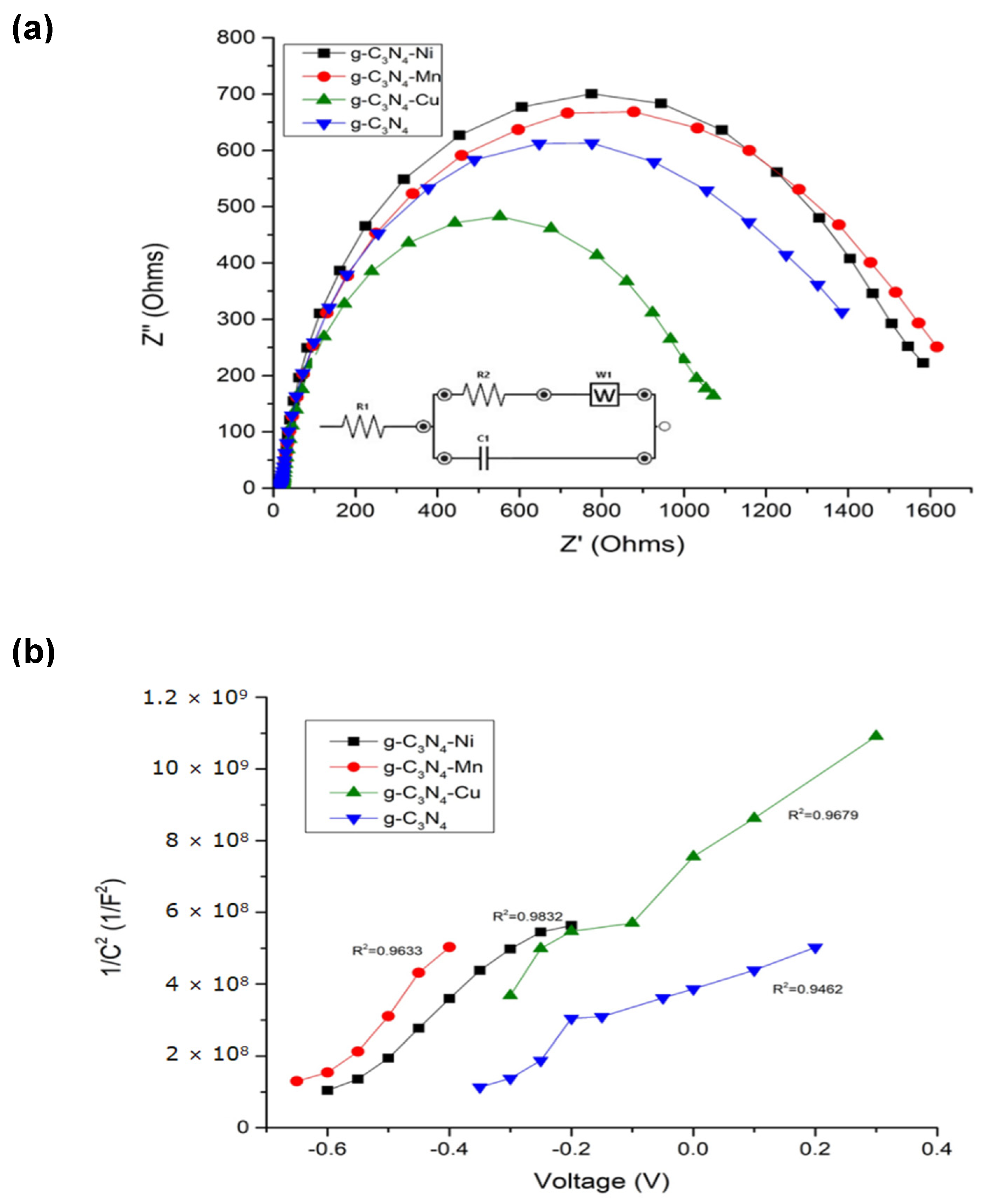

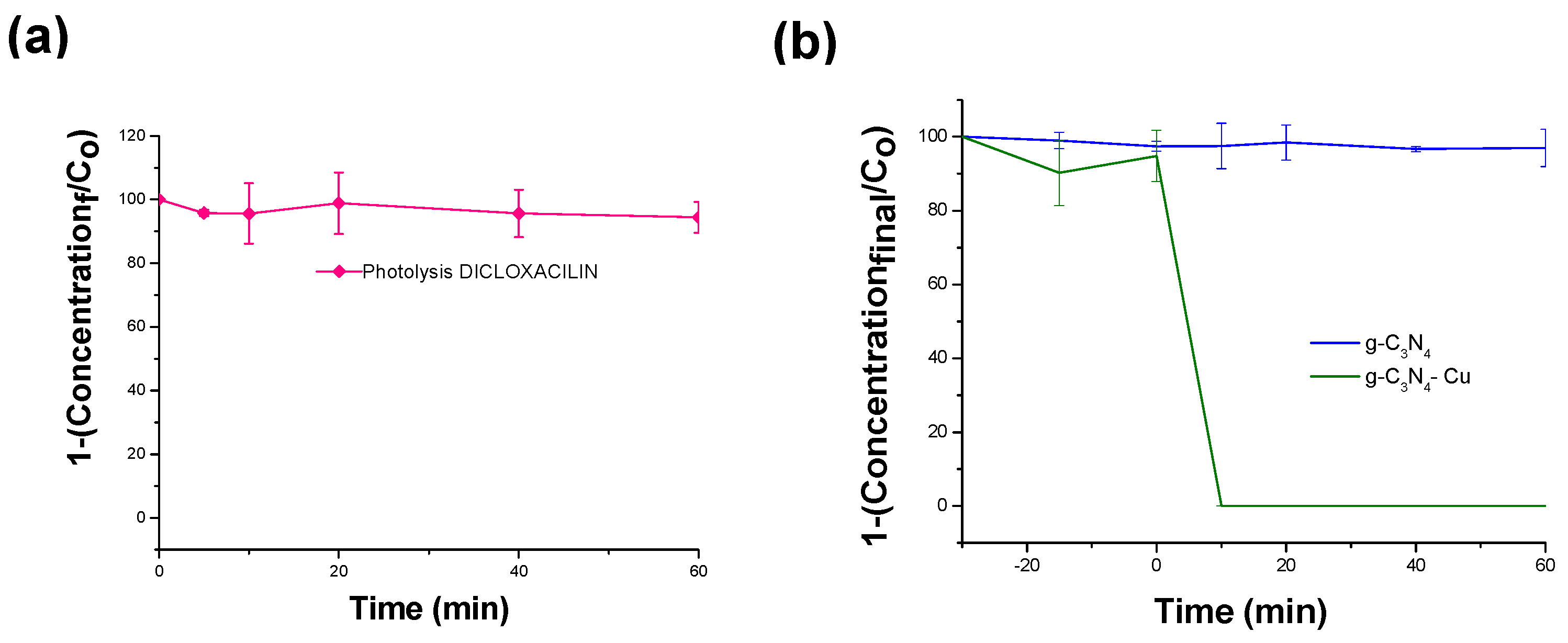
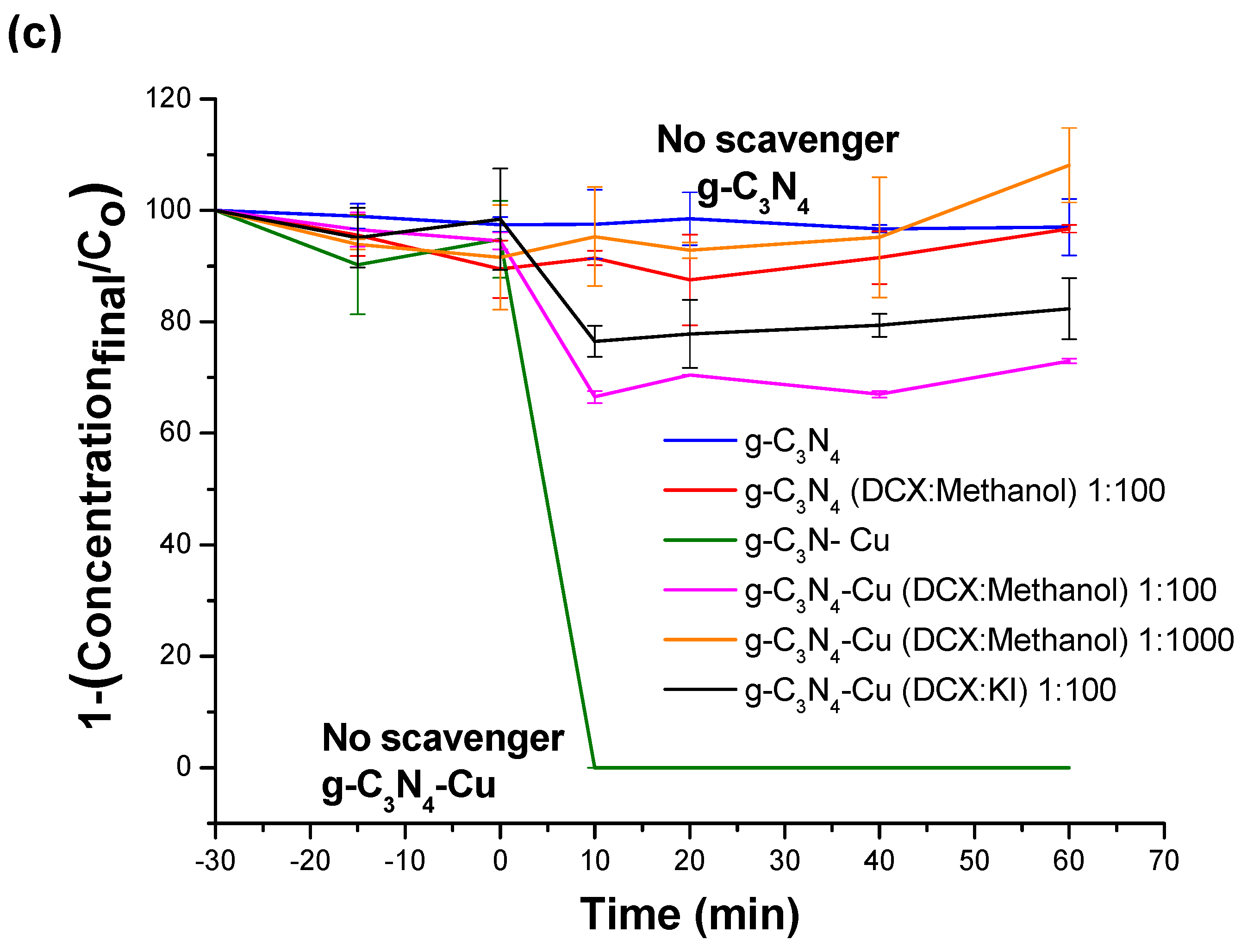
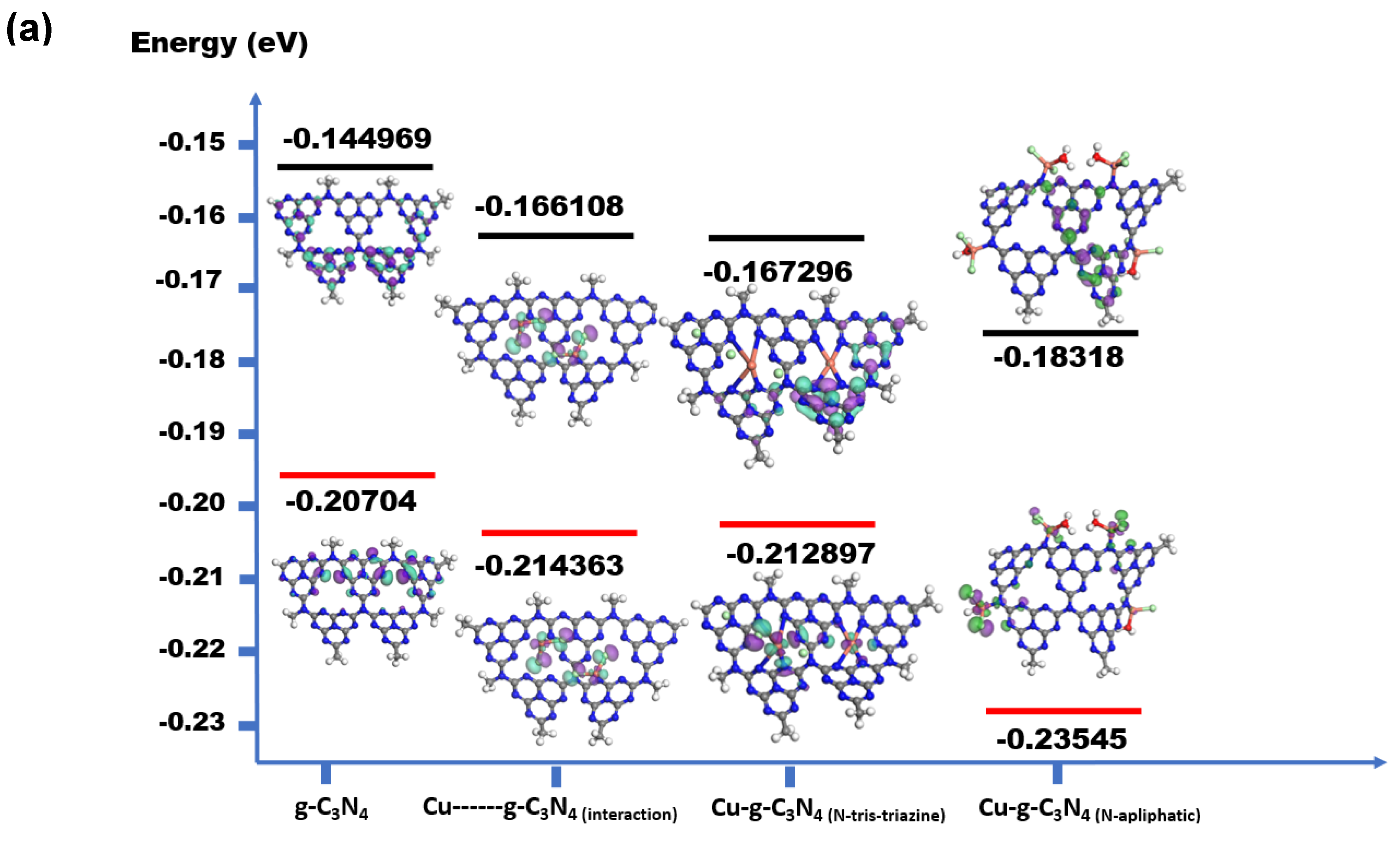
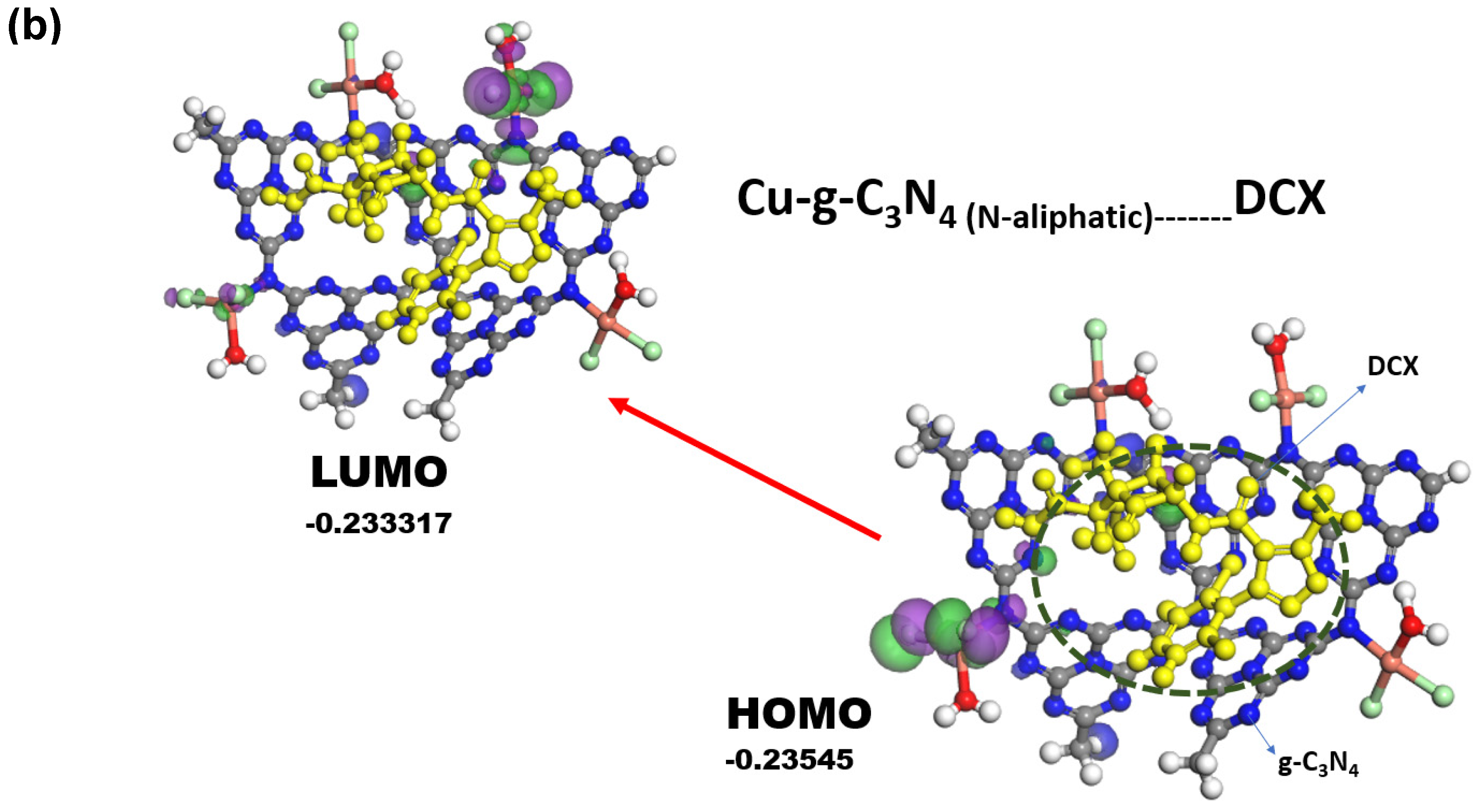
| Material | Theoretical Metal Amount (%) | Metal (%) | Carbon (%) | Nitrogen (%) | Oxygen (%) |
|---|---|---|---|---|---|
| g-C3N4 | --- | --- | 47.79 | 46.32 | 5.31 |
| Ni-g-C3N4 | 8.23 | 4.89 | 42.36 | 41.42 | 11.1 |
| Mn-g-C3N4 | 9.25 | 7.33 | 41.83 | 36.4 | 13.87 |
| Cu-g-C3N4 | 12.42 | 15.09 | 31.7 | 39.63 | 13.24 |
| Sample | Concentration (ppm) |
|---|---|
| Ni-g-C3N4 | 0 |
| Mn-g-C3N4 | 0.572 |
| Cu-g-C3N4 | 0 |
| g-C3N4 | Cu-g-C3N4 | Ni-g-C3N4 | Mn-g-C3N4 | |
|---|---|---|---|---|
| z-average (nm) | 2561 | 3714 | 2257 | 1309 |
| PC | −27.71 | −14.98 | −21.94 | −29.64 |
| Material | Pore Volume (cm3/g) | Pore Amount (%) | Pore Width (Å) | Hysteresis Degree (%) | Fractal Dimension | |||
|---|---|---|---|---|---|---|---|---|
| Micropore | Mesopore | Micropore | Mesopore | Micropore | Mesopore | |||
| g-C3N4 | 0.023 | 0.103 | 13.5 | 86.5 | 10.1 | 51.1 | 1.3 | 2.47 |
| Ni-g-C3N4 | 0.037 | 0.078 | 25.5 | 74.5 | 12.1 | 51.1 | 24.4 | 2.58 |
| Mn-g C3N4 | 0.015 | 0.157 | 7.1 | 92.9 | 12.7 | 51.1 | 4.2 | 2.42 |
| Cu-g-C3N4 | 0.013 | 0.120 | 7.8 | 92.2 | 12.1 | 53.4 | 9.8 | 2.48 |
Disclaimer/Publisher’s Note: The statements, opinions and data contained in all publications are solely those of the individual author(s) and contributor(s) and not of MDPI and/or the editor(s). MDPI and/or the editor(s) disclaim responsibility for any injury to people or property resulting from any ideas, methods, instructions or products referred to in the content. |
© 2024 by the authors. Licensee MDPI, Basel, Switzerland. This article is an open access article distributed under the terms and conditions of the Creative Commons Attribution (CC BY) license (https://creativecommons.org/licenses/by/4.0/).
Share and Cite
Lasso-Escobar, A.V.; Castrillon, E.D.C.; Acosta, J.; Navarro, S.; Correa-Penagos, E.; Rojas, J.; Ávila-Torres, Y.P. Modulation of Electronic Availability in g-C3N4 Using Nickel (II), Manganese (II), and Copper (II) to Enhance the Disinfection and Photocatalytic Properties. Molecules 2024, 29, 3775. https://doi.org/10.3390/molecules29163775
Lasso-Escobar AV, Castrillon EDC, Acosta J, Navarro S, Correa-Penagos E, Rojas J, Ávila-Torres YP. Modulation of Electronic Availability in g-C3N4 Using Nickel (II), Manganese (II), and Copper (II) to Enhance the Disinfection and Photocatalytic Properties. Molecules. 2024; 29(16):3775. https://doi.org/10.3390/molecules29163775
Chicago/Turabian StyleLasso-Escobar, Angie V., Elkin Darío C. Castrillon, Jorge Acosta, Sandra Navarro, Estefanía Correa-Penagos, John Rojas, and Yenny P. Ávila-Torres. 2024. "Modulation of Electronic Availability in g-C3N4 Using Nickel (II), Manganese (II), and Copper (II) to Enhance the Disinfection and Photocatalytic Properties" Molecules 29, no. 16: 3775. https://doi.org/10.3390/molecules29163775





